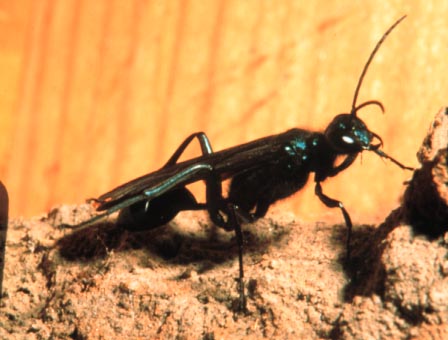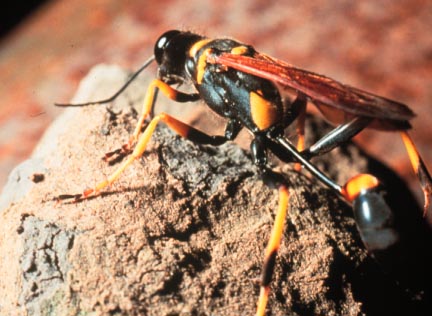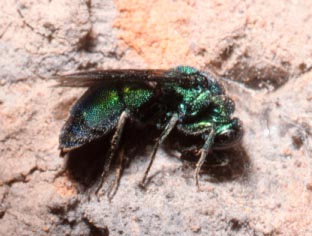
A blue mud dauber, Chalybion californicum Saussure (Hymenoptera: Sphecidae).
Photo by G. McIlveen, Jr.
Common Name: Mud daubers
Scientific Name: Chalybion, Sceliphron and other genera
Order: Hymenoptera: Sphecidae
Description: Adult mud daubers are 3/4 to 1 inch long wasps, varying in color by species from dull black to black with bright yellow markings to iridescent blue-black. The best identifying feature is the longer, narrow “waist” (petiole – the section between the thorax and abdomen).
Life Cycle: These are solitary wasp species, with nests constructed and provisioned by individual mated females. Eggs of mud daubers are laid singly on hosts in cells in mud nests provisioned with food, sealed and abandoned. Larvae grow up to 1 inch long and are cream-colored, legless and maggot-like. They pupate in cocoons within the cells and overwinter in nests. There can be several generations annually.
Habitat, Food Source(s), Damage: Mud daubers (Sphecidae) build small nests of mud under overhangs like eaves of buildings. The pipe organ mud dauber, Trypoxylon politum (Say) mud nests of long parallel tubes and provision their nests with spiders.

Black and yellow mud dauber,Chalybion caementarium (Drury)(Hymenoptera: Sphecidae). Photo by Jackman.
The black and yellow mud dauber, Sceliphron caementarium (Drury), constructs a globular nest containing one cell to several cells, also provisioned with paralyzed spiders. Adults are commonly seen in wet spots, balls of mud for building their nests. The iridescent blue mud dauber, Chalybion californicum (Saussure), takes over nests of the black and yellow mud dauber. It provisions its nest mostly with black widow spiders.
Pest Status: Mud daubers (Sphecidae) and potter or mason wasps (Eumeninae) are solitary wasp species; although capable of stinging, they are rarely aggressive. Mud dauber nests can be a nuisance in garages, under eaves and in other buildings.
For additional information, contact your local Texas A&M AgriLife Extension Service agent or search for other state Extension offices.
 Literature: McIlveen & Hamman 1991; Metcalf et al. 1962; Swan & Papp 1972.
Literature: McIlveen & Hamman 1991; Metcalf et al. 1962; Swan & Papp 1972.